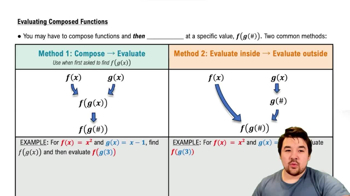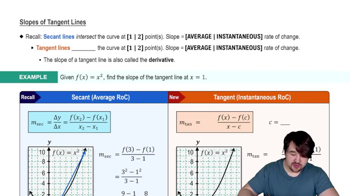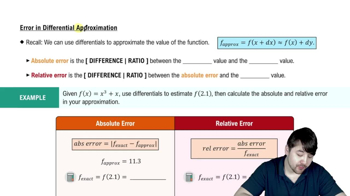Table of contents
- 0. Functions7h 52m
- Introduction to Functions16m
- Piecewise Functions10m
- Properties of Functions9m
- Common Functions1h 8m
- Transformations5m
- Combining Functions27m
- Exponent rules32m
- Exponential Functions28m
- Logarithmic Functions24m
- Properties of Logarithms34m
- Exponential & Logarithmic Equations35m
- Introduction to Trigonometric Functions38m
- Graphs of Trigonometric Functions44m
- Trigonometric Identities47m
- Inverse Trigonometric Functions48m
- 1. Limits and Continuity2h 2m
- 2. Intro to Derivatives1h 33m
- 3. Techniques of Differentiation3h 18m
- 4. Applications of Derivatives2h 38m
- 5. Graphical Applications of Derivatives6h 2m
- 6. Derivatives of Inverse, Exponential, & Logarithmic Functions2h 37m
- 7. Antiderivatives & Indefinite Integrals1h 26m
- 8. Definite Integrals4h 44m
- 9. Graphical Applications of Integrals2h 27m
- 10. Physics Applications of Integrals 2h 22m
4. Applications of Derivatives
Differentials
Problem 4.8.5
Textbook Question
Let ƒ(x) = 2x³ - 6x² + 4x. Use Newton’s method to find x₁ given that x₀ = 1.4. Use the graph of f (see figure) and an appropriate tangent line to illustrate how x₁ is obtained from x₀ . <IMAGE>
 Verified step by step guidance
Verified step by step guidance1
Newton's method is an iterative process used to approximate the roots of a real-valued function. The formula for Newton's method is: x_{n+1} = x_n - \frac{f(x_n)}{f'(x_n)}.
First, we need to find the derivative of the function f(x) = 2x^3 - 6x^2 + 4x. The derivative, f'(x), is calculated as follows: f'(x) = \frac{d}{dx}(2x^3 - 6x^2 + 4x) = 6x^2 - 12x + 4.
Next, substitute x_0 = 1.4 into the function f(x) and its derivative f'(x) to find f(1.4) and f'(1.4).
Calculate f(1.4) = 2(1.4)^3 - 6(1.4)^2 + 4(1.4) and f'(1.4) = 6(1.4)^2 - 12(1.4) + 4.
Finally, use the Newton's method formula to find x_1: x_1 = 1.4 - \frac{f(1.4)}{f'(1.4)}. This will give you the next approximation of the root, x_1.
 Verified video answer for a similar problem:
Verified video answer for a similar problem:This video solution was recommended by our tutors as helpful for the problem above
Video duration:
1mPlay a video:
Was this helpful?
Key Concepts
Here are the essential concepts you must grasp in order to answer the question correctly.
Newton's Method
Newton's Method is an iterative numerical technique used to approximate the roots of a real-valued function. It starts with an initial guess and uses the function's derivative to find successively better approximations. The formula for updating the guess is x₁ = x₀ - f(x₀)/f'(x₀), where f' is the derivative of f. This method is particularly effective when the initial guess is close to the actual root.
Recommended video:

Evaluating Composed Functions
Derivative
The derivative of a function measures how the function's output changes as its input changes. It is defined as the limit of the average rate of change of the function as the interval approaches zero. In the context of Newton's Method, the derivative is crucial for determining the slope of the tangent line at the current guess, which guides the next approximation towards the root.
Recommended video:

Derivatives
Tangent Line
A tangent line to a curve at a given point is a straight line that touches the curve at that point and has the same slope as the curve at that point. In Newton's Method, the tangent line at the point (x₀, f(x₀)) is used to find the next approximation x₁. The intersection of this tangent line with the x-axis provides a new estimate for the root, illustrating how the method converges to the actual solution.
Recommended video:

Slopes of Tangent Lines







